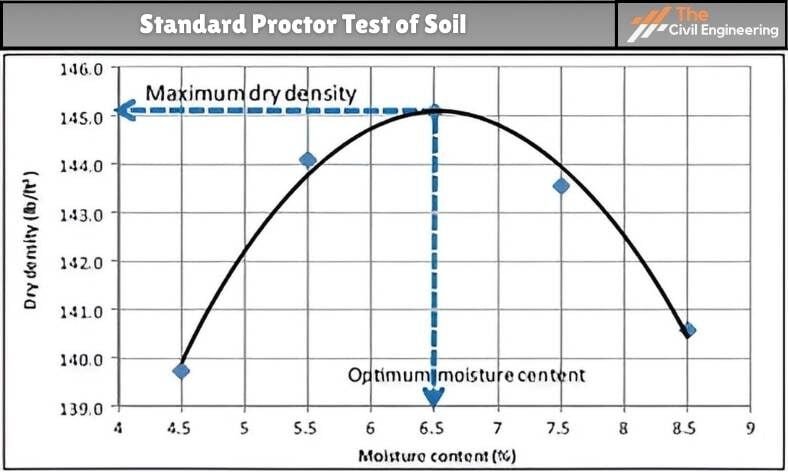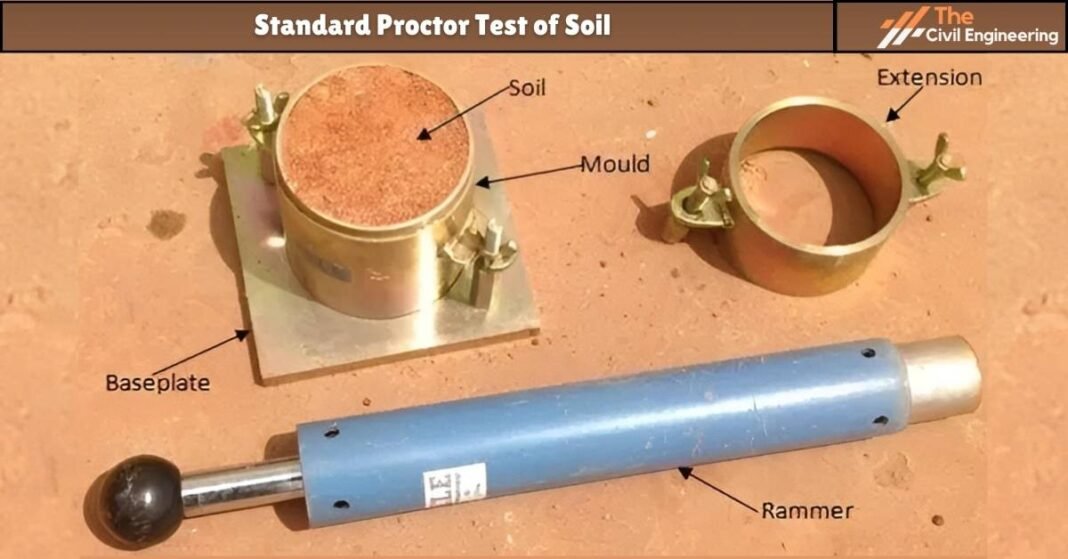R.R. Proctor developed Standard Proctor Test. This test is used to determine the optimum moisture content for the soil under given compaction.
1. Apparatus Required
a. Standard Proctor Apparatus

i. Cylindrical metal mold of an internal diameter of 4 inches ( 102 mm ) and effective height of 4.6 inches ( 117 mm ) with an internal volume of 1/30 cu. ft ( 0.945 ltr ).
ii. A 50 mm diameter rammer of weight 2.5 kg and height of fall of 1 foot ( 305 mm ), moving in the metallic outer sleeve.
iii. Detachable collar of 50 mm effective height ( 60 mm total height ).
iv. Detachable base plate
b. Thermostatically controlled oven (105°C +- 110°C)
c. Mixing Tools like a spoon, trowel, and spatula.
d. Tray & scoop
e. Containers
2. Procedure of Standard Proctor Test
i. About 3 kg of air-dried and pulverized soil passing through a 4.75 mm sieve is taken in a tray.
ii. The quantity of water to be added for the first trial is computed. The computed quantity of water is added to the soil in the tray and mixed thoroughly by hand to ensure uniform distribution of water.
iii. The mold is cleaned and dried and the weight of the empty mold with the base plate, but without a collar is taken ( say M1 ). The collar is then attached to the mold.
iv. The mold is filled with wet soil taken from a tray in 3 equal layers and compacted each layer with 25 uniformly distributed blows on the surface using a standard rammer of weight 2.5 kg.
The fall height of the rammer should be 12 inches.
v. The collar is removed and extra soil is trimmed off to make it level with the top of the mold.
vi. The weight of mold with base plate and compacted soil is taken ( say M2 ).
vii. Knowing the mass of compacted soil ( M2-M1 ), bulk density(ρ) is calculated.
i.e. Bulk Density(ρ) = M / V = (M2-M1) / V
Where V = Volume of soil ( which is the same as the volume of the mold).
viii. A representative sample of compacted soil is taken from the middle of the mold and its water content is determined. It is best to take 3 or more samples to determine water content.
The dry density of the soil is obtained as :
ρdry = ρ / (1+W)
ix. Several such tests are conducted with soil samples having different moisture content and ρdry workout for all the tests.
x. A graph is plotted between dry density and water content to obtain a compaction curve.

xi. The optimum moisture content and the corresponding maximum dry density are determined from the graph.
3. Observations & Calculations
Dia. of the mold =
Mould Height =
Mould Volume, V=
Specific gravity of soil, G=
| Sl. No. | Observations and Calculations | Determination No. | ||
| 1 | 2 | 3 | ||
| Observation | ||||
| 1 | Mass of empty mold with base plate | |||
| 2 | Mass of mold compacted soil and base plate | |||
| Calculations | ||||
| 3 | Mass of compacted soil M = (2) – (1) | |||
| 4 | Bulk Density |
|||
| 5 | Water content, w | |||
| 6 | Dry density |
|||
| 7 | Void ratio |
|||
| 8 | Dry density at 100% saturation (theoretical) |
|||
| 9 | Degree of saturation |
|||
4. Result
Maximum dry density (from the plot) =
Optimum water content (from the plot) =
5. Precautions in Standard Proctor Test
a. Soil should not contain excess moisture during the compaction process.
b. Mould used for compaction should be cleaned well before using.
6. Uses of Standard Proctor Test
a. This test is used to identify the compactness of soil to use in the construction of embankments, highways, foundations, pavements, and various earthworks.
b. It is also used to study soil mechanics and other properties like porosity, compressibility, strength, etc.
7. Advantages of Standard Proctor Test
a. The compact fill of soil given by the proctor test can aid to determine the degree of soil density.
b. This test also describes the load-bearing capacity of the soil.
c. Due to this test, we can use compacted soils in various engineering works to control soil erosion, reduce subsidence and freeze-thaw problems, etc.
d. It gives the information of water content in the soil with dry unit weight during the compaction procedure.
8. Disadvantages of Standard Proctor Test
a. During this test, air voids cannot be removed even after compacting.
b. The standard proctor test cannot be used in the case of construction of heavy structures.
| Read Also: Core Cutter Method |

